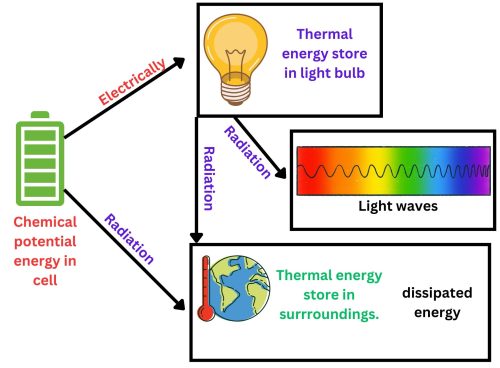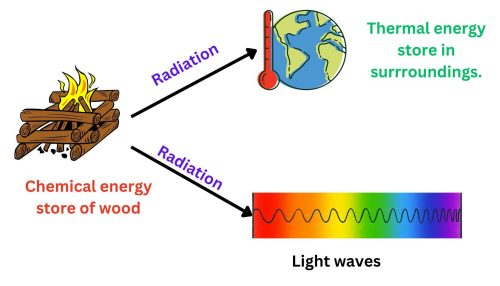Answers to AQA GCSE Conservation of energy(physics)
Answers to Practice Questions
1. Draw an energy transfer diagram for the following examples:
Include initial energy store, final energy stores (useful and wasted), how energy is transferred
a) Battery powered torch
b) Wood being burnt on a fire


2. A saucepan of soup is being heated on a cooker hob. The internal energy store of the metal saucepan gains 2000J of energy, whist the liquid soup increases its energy store by 1500J whilst being heated. Calculate the size of the thermal energy store of the heating element in the hob.
In this case, the total energy outputs are 2000J + 1500J, so 3500J. Therefore, as total energy input = total energy output, the total energy input is also 3500J.
3. A runner has Y amount of energy stored in his muscles as chemical energy. The runner goes for a run, 80% of the chemical energy is mechanically transferred into kinetic energy, whilst 20% of the energy is transferred to the thermal energy store of the surroundings by radiation. The thermal energy store of the surroundings increases by 500J during the run.
a) Calculate the gain in the kinetic energy store
Thermal energy store = 20%, so this is 500J.
Therefore 80% is four times greater, so it will be 2000J.
b) Calculate the size of Y (chemical potential energy store.)
2000J + 500J = 2500J.
Need more questions, try our worksheets.
Absorption and Emission of EM Radiation
JJ Thomson and Plum pudding model
Ernest Rutherford and the Nuclear Model
Niels Bohr changing the Nuclear Model
Discovering the Proton and Neutron
Measuring radiation from radioactivity
Radiation types and properties
Random nature of radioactive decay
Radioactive contamination or irradiation
Hazards of contamination and irradiation
Studies on the effects of radiation on humans
Different half lives of radioactive isotopes
Nuclear Fission Chain Reaction
Writing nuclear fission equations
Drawing ray diagrams for a concave lens
Drawing Ray Diagram to produce a virtual image for a convex lens
Drawing ray diagram to produce a real image for a convex lens.
Specular and Diffuse Reflection
Seeing Coloured Objects Part 2
Viewing objects through coloured filters
Transparent, Translucent and Opaque
Accordion Content
Accordion Content
